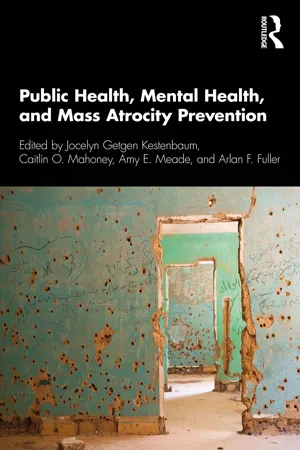
Public Health, Mental Health, and Mass Atrocity Prevention
- 264 pages
- English
- ePUB (mobile friendly)
- Available on iOS & Android
Public Health, Mental Health, and Mass Atrocity Prevention
About This Book
This multidisciplinary volume considers the role of both public health and mental health policies and practices in the prevention of mass atrocity, including war crimes, crimes against humanity, and genocide.
The authors address atrocity prevention through the framework of primary (pre-conflict), secondary (mid-conflict), and tertiary (post-conflict) settings. They examine the ways in which public health and mental health scholars and practitioners currently orient their research and interventions and the ways in which we can adapt frameworks, methods, tools, and practice toward a more sophisticated and truly interdisciplinary understanding and application of atrocity prevention. The book brings together diverse fields of study by global north and global south authors in diverse contexts. It culminates in a narrative that demonstrates the state of the current fields on intersecting themes within public health, mental health, and mass atrocity prevention and the future potential directions in which these intersections could go. Such discussions will serve to influence both policy makers and practitioners in these fields toward developing, adapting, and testing frames and tools for atrocity prevention. Multidisciplinary perspectives are represented among editors and authors, including law, political science, international studies, public health, mental health, philosophy, clinical psychology, social psychology, history, and peace studies.
Frequently asked questions
PART I
Linking concepts of public health, mental health, and mass atrocity prevention
1
(RE)CONCEPTUALIZING ATROCITY CRIMES AS PUBLIC HEALTH CATASTROPHES
I Introduction: the current framing of atrocities as violent spectacles
Table of contents
- Cover
- Half Title
- Title Page
- Copyright Page
- Table of Contents
- Author biographies
- Contributors list
- Foreword
- Acknowledgments
- Introduction
- Part I Linking concepts of public health, mental health, and mass atrocity prevention
- Part II Supporting mental and public health prevention work in pre-atrocity, atrocity, and post-atrocity settings
- Part III Group identity, victim impact, and community relationships in atrocity contexts
- Part IV Ways forward
- Conclusion
- Index